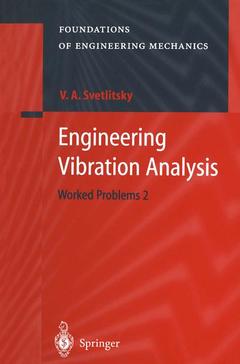Description
Engineering Vibration Analysis, Softcover reprint of hardcover 1st ed. 2004
Worked Problems 2
Foundations of Engineering Mechanics Series
Author: Svetlitsky Valery A.
Language: English
Subject for Engineering Vibration Analysis:
Engineering Vibration Analysis
Publication date: 12-2010
239 p. · 15.5x23.5 cm · Paperback
Publication date: 12-2010
239 p. · 15.5x23.5 cm · Paperback
Engineering vibration analysis : worked problems 2, (Foundations of engineering mechanics)
Publication date: 02-2004
239 p. · 15.5x23.5 cm · Hardback
Publication date: 02-2004
239 p. · 15.5x23.5 cm · Hardback
Description
/li>Contents
/li>Comment
/li>
Constantly increasing attention is paid in the course 'Vibration 'Theory' to vibration of mechanical systems with distributed parameters, since the real elements of machines, devices, and constructions are made of materials that are not perfectly rigid. 'Therefore, vibrations of the objects including, for ex ample, rod elastic elements excite the vibrations of these elements, which can produce a substantial effect on dynamic characteristics of moving objects and on readings of instruments. For a mechanical engineer working in the field of design of new technolo gies the principal thing is his know-how in developing the sophisticated math ematical models in which all specific features of operation of the objects under design in real conditions are meticulously taken into account. So, the main emphasis in this book is made on the methods of derivation of equations and on the algorithms of solving them (exactly or approximately) taking into con sideration all features of actual behavior of the forces acting upon elastic rod elements. 'The eigen value and eigen vector problems are considered at vibrations of curvilinear rods (including the rods with concentrated masses). Also consid ered are the problems with forced vibrations. When investigating into these problems an approximate method of numerical solution of the systems of lin ear differential equations in partial derivatives is described, which uses the principle of virtual displacements. Some problems are more complicated than others and can be used for practical works of students and their graduation theses.
1 Problems and Examples.- 2 Answers and solutions.- References.- A Statics of rods: basic equations.- A.1 Derivation of nonlinear equations of rod equilibrium.- A.2 Transformations of base vectors.- A.5 Vector equation of displacements of points of the rod axial line.- A.7 System of nonlinear equations of rod equilibrium.- A.8 Reduction of equations to dimensionless notation.- A.9 Boundary conditions.- A.10 External load and its behaviour under rod loading process.- A.11 Vector nonlinear equations of rod equilibrium in the bound coordinate system.- A.12 Equations of rod equilibrium in projections onto bound axes.- A.13 Special cases of equilibrium equations.- B Basic equations of rod kinematics.- B.2 Absolute and local derivatives of a vector with respect to time.- B.3 Velocity and acceleration of a point of the rod axial line.- C Basic equations a rod dynamics.- C.1 Nonlinear vector equations of motion of three-dimensional curvilinear rods.- C.2 Reduction of equations to dimensionless form.- C.3 Equations of small vibrations of rods (linear equations).- C.4 Equations of small vibrations in projections onto bound axes.- C.5 Equations of small vibrations of a rod whose axial line in the unloaded state is a plane curve.- D Exact numerical method of determining the frequencies and modes of rod vibrations.- D.1 Determination of eigen values (frequencies).- D.2 Determination of eigen functions for conservative problems.- E Approximate numerical determination of frequencies at small vibrations of rods.- F Approximate solution of equation of rod forced vibrations.
Selected topics of the advanced theory of vibrations Includes supplementary material: sn.pub/extras
© 2024 LAVOISIER S.A.S.
These books may interest you

Theory of Vibration Protection 158.24 €

Theory of Vibration Protection 158.24 €


